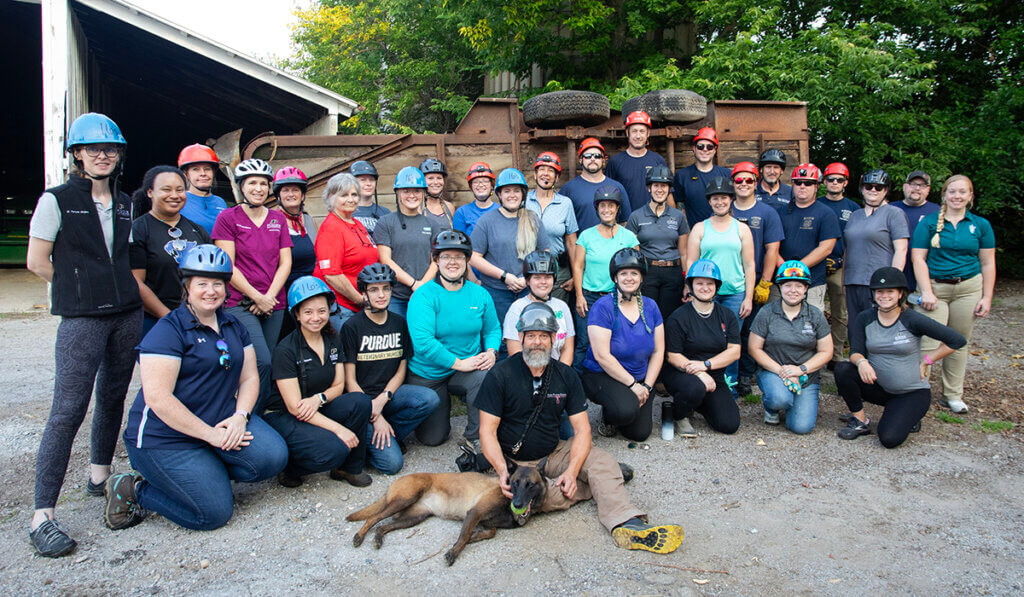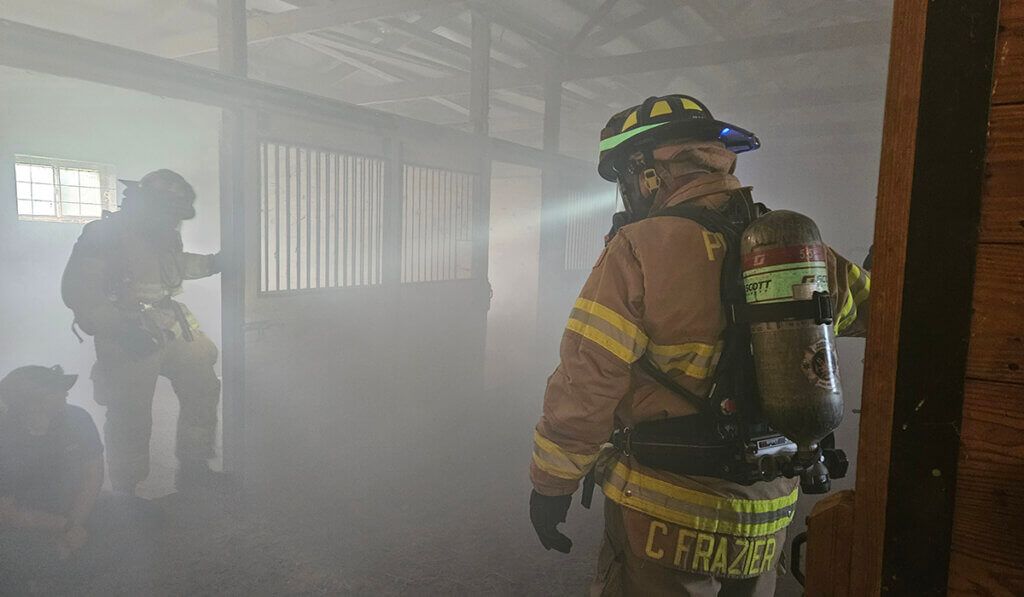
Picture a large animal trailer overturned or stuck in the mud, with animals trapped inside. Imagine that you are responsible to rescue them. That is a daunting proposition, but it is something that veterinary professionals and fire department rescue personnel have to be ready to deal with on any day and at a moment’s notice. Technical Large Animal Emergency Rescue (TLAER) addresses large animal emergency situations by training people how to safely help and extract the animals.
That is why a joint TLAER training exercise involving the Purdue University College of Veterinary Medicine and Purdue University Fire Department (PUFD) was regarded as exceptional and invaluable by the 35 participants. The three-day program in August featured hands-on exercises that took place at the Veterinary Farm on South River Road, with additional classroom sessions and a horse-caught-in-a-manhole simulation at the Physical Facilities Service Building on Ahlers Drive.
Organized through a partnership between Purdue’s Administrative Operations (AO) and College of Veterinary Medicine (PVM), the program utilized a horse mannequin that was placed in disaster settings, enabling the veterinary medical and PUFD personnel to learn techniques for keeping animals and themselves safe during emergency rescues, such as a horse caught in a burning barn, trapped in an overturned trailer, or caught by the leg in a broken wooden bridge deck. The simulations marked the first time Purdue has hosted this type of training.
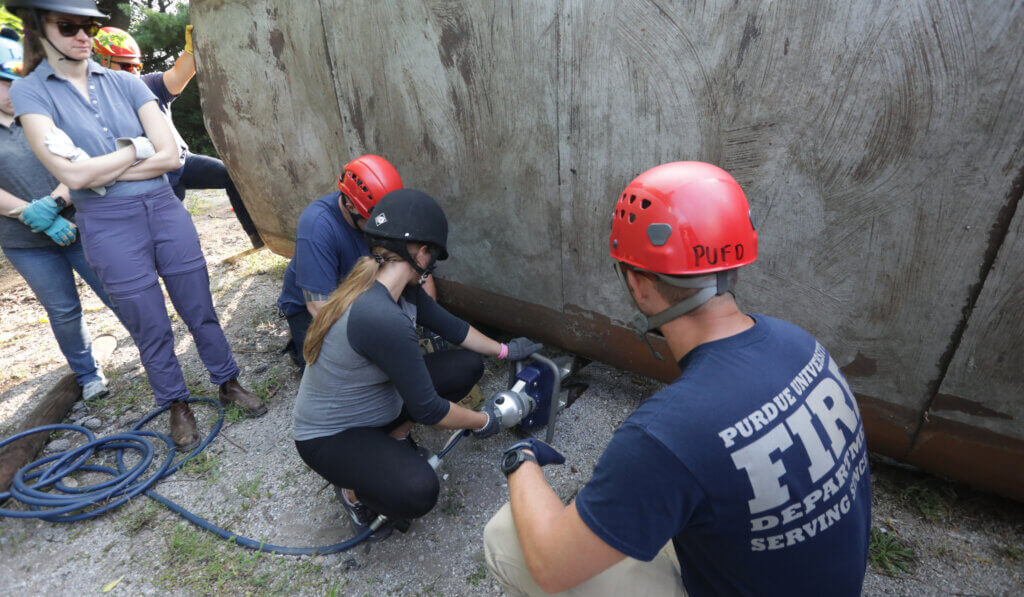
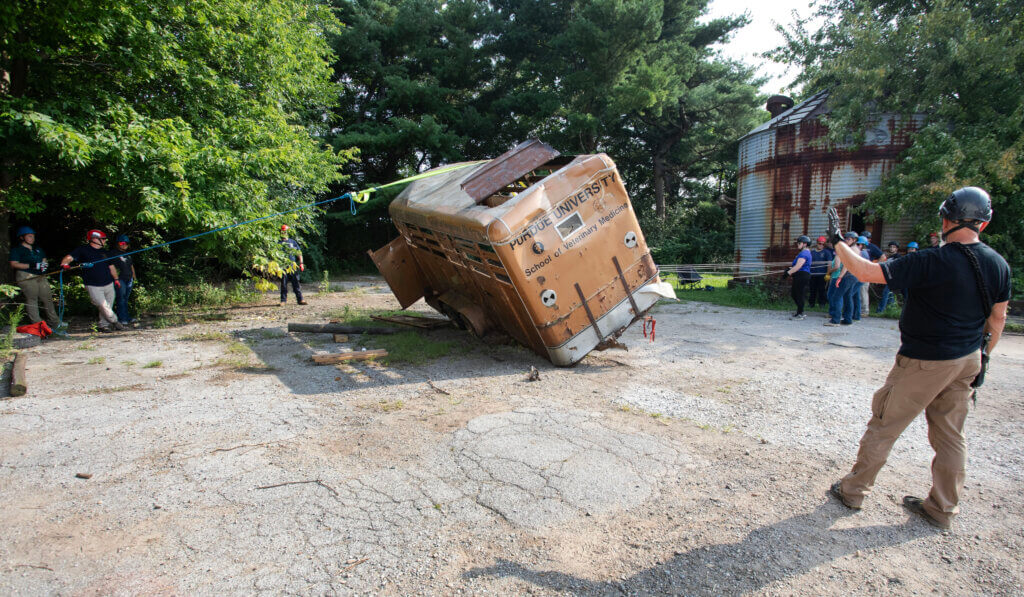
Personnel from PUFD and the Morgantown Volunteer Fire Department joined with PVM clinicians, staff, and students to participate in the training. The PVM attendees represented the college’s Equine and Farm Animal Hospitals as well as Bovine Field Services, Anesthesia and Diagnostic Imaging, and the Caesars Entertainment Equine Specialty Hospital in Shelbyville. They included veterinarians and veterinary nurses, residents, interns, and DVM students.
Robin Ridgway, director of Environmental Health and Safety Compliance, part of the AO organization, was instrumental in developing the partnership that brought TLAER to Purdue. Ridgway co-authored a publication on horse trailer safety for Purdue Extension. This co-authorship led the Morgantown Fire Department and the Purdue University Veterinary Hospital to Ridgway.
“To me as a horse owner, it made a lot of sense to have a partnership between the veterinary college and our fire department, not only for managing potential issues in our own hospital that serves the community, but also for possible emergencies in the areas surrounding Purdue,” said Ridgway.
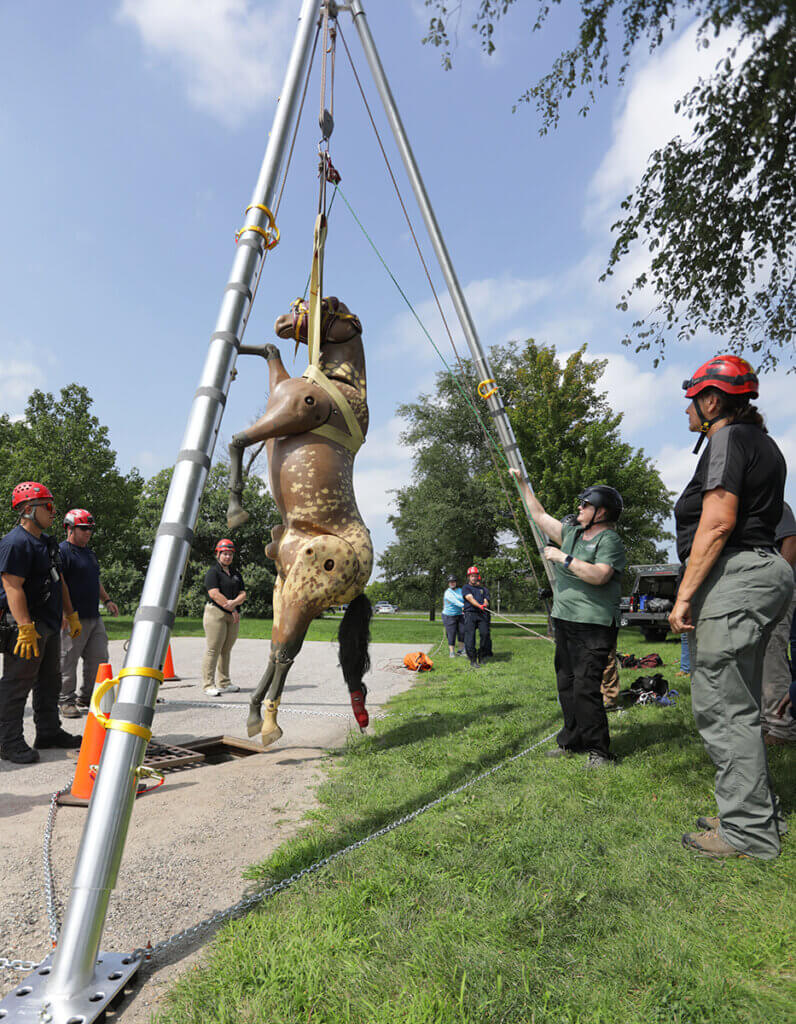
The College of Veterinary Medicine funded the training and invited PUFD to participate. “This training is invaluable for our veterinary hospital staff. It helps us to provide safer care for our patients as well as a safer environment for our team,” said Amy Balser, Veterinary Hospital clinical services coordinator and interim large animal nursing supervisor. “It created a stronger working relationship between the large animal services in the hospital and fire department that will be critical in safely maneuvering injured animals that arrive at the hospital.”
Purdue Fire Chief Brad Anderson was eager to have PUFD participate in the training. “Purdue is unique, having its own fire department,” Chief Anderson said. “In addition to providing fire and emergency medical services to the Purdue West Lafayette campus, we continually look for opportunities to collaborate with groups across campus. TLAER was a great opportunity to partner with Purdue Veterinary Medicine and support a new opportunity for veterinary students. It also allows us to provide a new service to the community. Fire department staff are trained, equipped, and experienced in a variety of technical rescue disciplines including rope rescue, confined space, and vehicle extrication.”
As part of AO and someone who is familiar with university organizations and facilities, Ridgway was happy to take on the role of training coordinator, working with Waterworks, Grounds, and other departments.
Balser said her first exposure to this kind of training was several years ago when she attended a similar session while working as a zookeeper at the Kansas City Zoo. “I have seen how that training enabled me to work more safely and train others to do so as well.”
The training at Purdue was led by Dr. Rebecca (Gimenez) Husted, who is an educator, facilitator, and consultant for TLAER. She has a long history of providing this kind of training and was involved in writing and editing the first textbook on this subject. She has conducted training worldwide, in more than ten countries and across the United States.
“Incident command, teamwork, leadership, and followership are the skills that allow better employment of the techniques and methodologies we teach, while ensuring that the equipment is utilized correctly,” Dr. Husted said. “Without the former, having the latter does not do a thing. Once you see it, you can’t unsee it, and in general once people ‘get it’ they really GET IT and can apply the concepts to any situation. The joint participation of the veterinary medical staff and students with the fire department allows each organization to bring their expertise and skills to a real event and by knowing each other as well as each one’s strengths and weaknesses, they are able to leverage the resources and knowledge to make responses more efficient and more successful.”
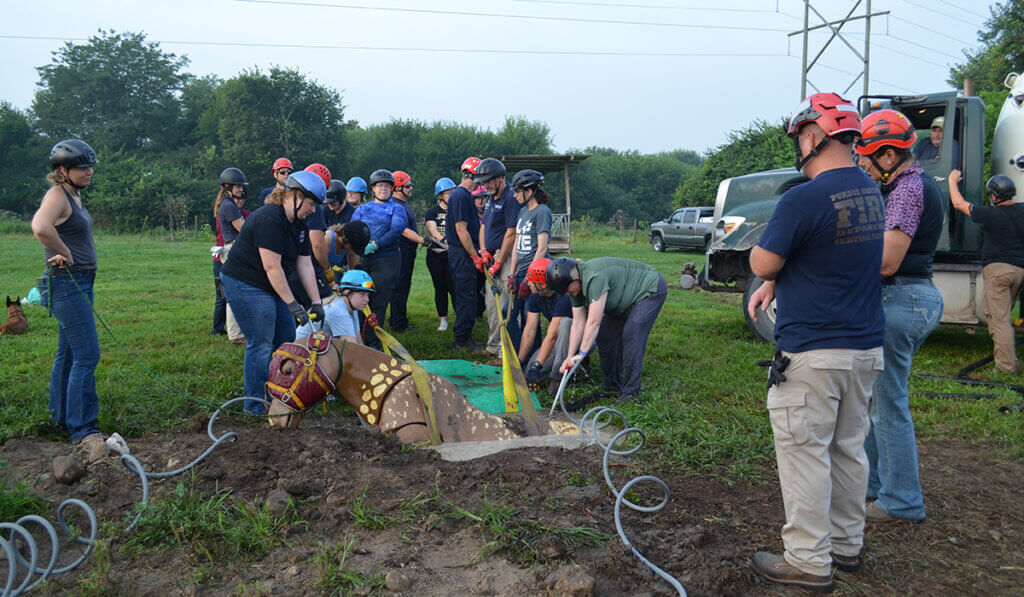
Balser said she reached out to Dr. Husted three years ago to initiate discussion of the training. Ridgeway connected Chief Anderson, firefighter Corey Matricia, and Balser early in 2023 because the PUFD was interested in attaining the training and partnering with the Veterinary Hospital to work toward establishment of a local team to respond to these kinds of large animal emergencies.
“In my courses, I tell the fire department that they simply must have veterinary expertise available and preferred on scene,” Dr. Husted said. “And I tell veterinarians that they really need to consider having the fire department on scene sooner than later because their job is a puzzle solving job.”
In the case of an animal rescue, PUFD personnel can provide the technical rescue expertise, scene management capability, and emergency medical services, complimenting the skill and ability of the campus veterinary staff. PUFD serves as a liaison between other agencies to safely facilitate animal rescue.
Reflecting on the training, Chief Anderson said, “TLAER was an excellent opportunity for both Purdue Veterinary Medicine and the fire department to practice and develop those skills. I am excited to see this program develop over the next several years. This program demonstrates how collaboration can benefit multiple departments, Purdue students, our community, and beyond.”
Balser said the response from the Veterinary Hospital team that attended was amazingly positive. “They immediately began identifying elements in the Veterinary Hospital’s existing large animal procedures and protocols that could be enhanced by incorporating techniques learned at the training to increase our team and patient safety.”
PUFD, Environmental Health and Safety Compliance, Waterworks, and Grounds are all a part of the Administrative Operations organization. The organization supports the university by providing safe, reliable, and transformative services. Coordinating training efforts and providing professional and safety development opportunities are just a couple of the ways the organization helps power Purdue.
